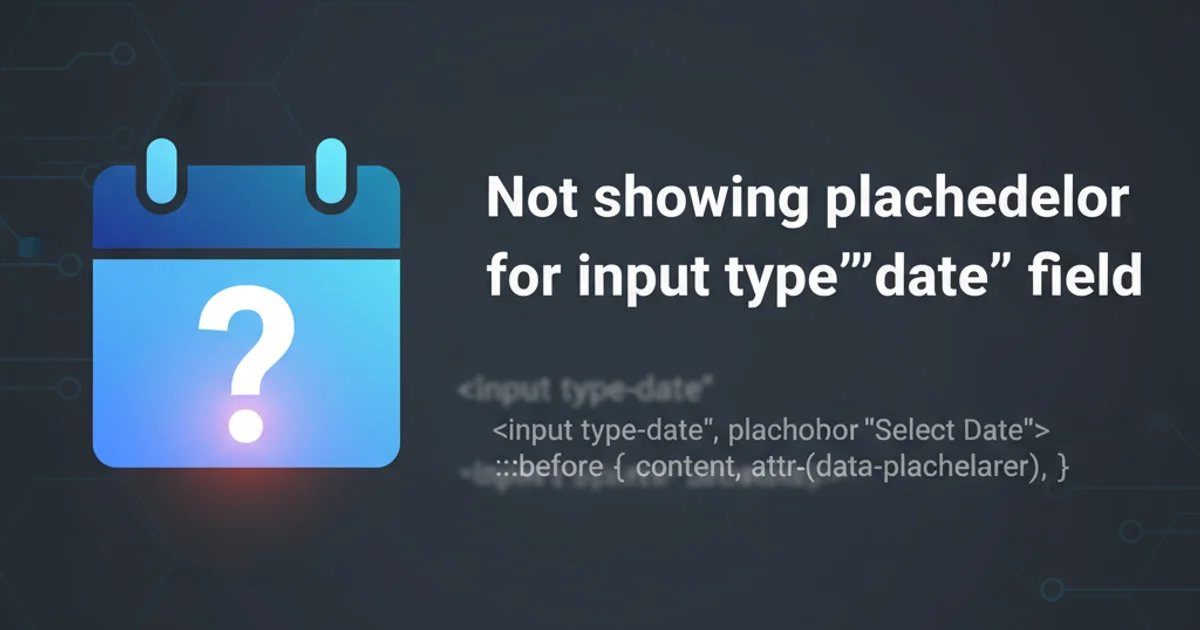Not showing placeholder for input type="date" field
Categories:
Understanding and Addressing Missing Placeholders in HTML Date Inputs

Explore why the placeholder attribute doesn't work with input type="date" fields and discover effective workarounds for providing user guidance in date selection.
The input type="date" element is a powerful HTML5 feature that provides a native date picker interface to users, enhancing usability and ensuring valid date formats. However, a common frustration for developers is the apparent lack of support for the placeholder attribute on these fields. Unlike type="text" or type="email", simply adding placeholder="Select a Date" to a date input often yields no visible result. This article delves into the reasons behind this behavior and offers practical solutions to guide users effectively.
Why placeholder Doesn't Work for type="date"
The behavior of the placeholder attribute is intrinsically linked to the nature of the input type. For type="text", type="email", type="password", etc., the placeholder provides a hint for textual input. When the field is empty, the hint is displayed. However, input type="date" is designed to handle a specific data type (a date) and often relies on the browser's native UI for selection, rather than direct text entry.
Browsers typically render type="date" fields with a default format (e.g., MM/DD/YYYY or YYYY-MM-DD) and often include a calendar icon. The 'empty' state of a date input is usually represented by this default format or an empty string, not a space for a textual hint. The browser's native date picker UI is responsible for guiding the user, making a textual placeholder redundant in the eyes of the HTML specification and browser implementations.
flowchart TD
A[User sees date input] --> B{Is input type="date"?}
B -- Yes --> C[Browser renders native date picker UI]
C --> D{Does browser support placeholder for date?}
D -- No (Standard behavior) --> E[Placeholder ignored/not displayed]
D -- Yes (Non-standard/Polyfill) --> F[Placeholder displayed]
B -- No --> G[Browser renders standard text input]
G --> H{Is placeholder attribute present?}
H -- Yes --> I[Placeholder displayed]
H -- No --> J[No placeholder]Flowchart illustrating placeholder behavior for different input types
Effective Workarounds for User Guidance
While a direct placeholder might not work, several strategies can provide excellent user guidance for input type="date" fields. The best approach often depends on the specific context and desired user experience.
1. Using Labels and Helper Text
The most semantically correct and accessible way to guide users is by using a <label> element associated with the input, combined with additional helper text if needed. This clearly describes the purpose of the field.
<label for="eventDate">Event Date:</label>
<input type="date" id="eventDate" name="eventDate">
<small>Please select the date of the event.</small>
Basic HTML structure with label and helper text
2. Leveraging the title Attribute
The title attribute provides a tooltip on hover, which can offer a brief hint. While not a direct placeholder, it can serve as supplementary information.
<label for="bookingDate">Booking Date:</label>
<input type="date" id="bookingDate" name="bookingDate" title="Choose your desired booking date">
Using the title attribute for a tooltip hint
3. JavaScript-based Placeholder Simulation
For more control or a specific visual style, you can simulate placeholder behavior using JavaScript. This typically involves setting the value attribute to a default string (e.g., "YYYY-MM-DD") and clearing it on focus, then restoring it if the user doesn't select a date. This method requires careful implementation to avoid accessibility issues and ensure proper form submission.
HTML
JavaScript (More Robust)
document.addEventListener('DOMContentLoaded', function() { const dateInput = document.getElementById('jsDate'); const defaultPlaceholder = 'YYYY-MM-DD';
// Set initial value if empty if (!dateInput.value) { dateInput.setAttribute('data-placeholder', defaultPlaceholder); dateInput.style.color = '#aaa'; // Style to look like placeholder }
dateInput.addEventListener('focus', function() { if (this.value === '' && this.getAttribute('data-placeholder')) { this.value = ''; this.style.color = '#000'; } });
dateInput.addEventListener('blur', function() { if (!this.value) { this.setAttribute('data-placeholder', defaultPlaceholder); this.style.color = '#aaa'; } });
// Handle form submission to clear placeholder if still present dateInput.form.addEventListener('submit', function() { if (dateInput.value === '' && dateInput.getAttribute('data-placeholder')) { dateInput.value = ''; // Ensure empty string is submitted } }); });
CSS (for placeholder styling)
input[type="date"][data-placeholder]:not(:focus):not(:valid) { color: #aaa; }
input[type="date"][data-placeholder]:not(:focus):not(:valid)::before { content: attr(data-placeholder); width: 100%; position: absolute; left: 0; top: 0; padding: 1px 2px; color: #aaa; pointer-events: none; }
4. Using a JavaScript Date Picker Library
If native browser support for type="date" doesn't meet your design or functionality requirements (e.g., for specific date formats, range selections, or advanced features), a JavaScript date picker library (like jQuery UI Datepicker, Flatpickr, or Pikaday) can be a robust solution. These libraries often allow full control over placeholder text, formatting, and styling.
<!-- Example using a hypothetical JS date picker -->
<label for="customDate">Custom Date:</label>
<input type="text" id="customDate" name="customDate" placeholder="DD/MM/YYYY">
HTML for a custom date picker (note type="text")
// Example of initializing a custom date picker (e.g., Flatpickr)
// Make sure to include the Flatpickr library in your project
// flatpickr("#customDate", {
// dateFormat: "d/m/Y",
// placeholder: "DD/MM/YYYY"
// });
JavaScript initialization for a custom date picker library
type back to "text" to allow the library to manage the input's value and display its custom placeholder. The library will then handle the date validation and formatting.